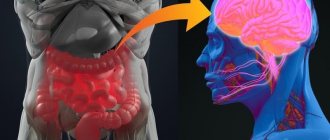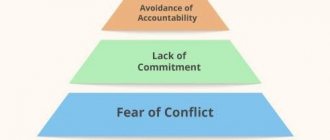Five years. That’s how long I’ve been treating my anxiety disorder. During this time, I managed to sit in the chair of a gestaltist, a cognitive behavioral therapist, a psychiatrist, and even a Vedic woman.
I took a mountain of pills, learned not to identify myself with my thoughts, found out where anxiety “lives” in the body, and memorized my childhood psychotraumas.
But despite all these successes, until recently I lived with a background feeling of anxiety, which was aggravated by minor stress or too much joy. Therefore, when I was offered to go to a transpersonal psychotherapist who uses “other” methods, I agreed. I had nothing to lose, and I was tired of wishing for “peace” for the New Year - I wanted to finally find it.
40-year-old Olga had a different request. For several years she suffered from depression, the causes of which were professional burnout and endless worries about her son. Every day she choked with tears, the woman practically did not get out of bed. At some point, she came across the contact of a specialist who was ready to help in such a situation.
So, with a difference of several months, Olga and I found ourselves at an appointment with psychotherapist Vladislav Matrenitsky, who works within the framework of the transpersonal approach.
New frontiers of human nature
Increased public interest in Eastern spiritual practices and the availability of psychedelic substances encouraged scientists in the 1960s to study altered states of consciousness.
Psychoanalysis, behaviorism, and humanistic psychology could not fully describe the experiences of people who took LSD and practiced yoga and meditation.
Therefore, transpersonal psychology appeared, whose adherents focused on the spiritual world of man and transformation techniques that can help one feel one’s integrity and unity with the cosmos.
This direction was based on the ideas of psychologist William James and psychoanalysts Carl Gustav Jung and Otto Rank. Without James, the study of spiritual experience would not have begun at all: it was he who stood at the origins of psychological studies of religiosity. The concept of archetypes was borrowed from Jung, and from Rank the concept of the first mental trauma that a person receives at birth.
Abraham Maslow, the author of the hierarchy of human needs model (Maslow's pyramid), was one of the pioneers of the transpersonal approach. He was the first to talk about the individual’s desire to know his capabilities and reach their limits, and he considered transpersonal psychology the “fourth force” of American psychology, which will explore the “further frontiers of human nature.”
The point of such therapy is to use various techniques to get to the deep layers of the psyche, bypassing the rationalizing mind. It is believed that this is where all the answers to the questions tormenting the patient are stored, and if he finds them, he will be healed.
What is transpersonal psychology
The essence of the term “transpersonal psychology” (TP) can be directly reduced to the equivalent of psychology “beyond the personality,” “through the personality.” She examines special (transpersonal) states of our psyche and consciousness. Here methods are created that can solve problems that exist outside and inside the individual, as well as methods of self-knowledge, self-improvement and self-realization, and ensuring the growth of spiritual potential.
TP has an interesting and broad subject of study:
- features of an expanded state of consciousness;
- phenomena of parapsychology;
- spiritual practices in the context of psychiatry and psychology, including religious ones (in Buddhism, Hinduism, Christian mysticism, shamanism, etc.);
- psychopharmacology and action of psychedelic drugs;
- methods of breathing influence on the mental state (holotropic breathing, rebirthing); healing practices of peoples (Indians, etc.);
- meditation and yoga practice;
- processes of aging, death and dying;
- features of spiritual growth.
TP “aims” to cover an integrative, complete picture of all things: after all, the paradigm and all the developments of various sciences describe only a limited part of reality.
Breathe out psychological trauma
The most famous figure in transpersonal psychology is the Czech-American psychologist Stanislav Grof. In his opinion, human mental disorders are personal and spiritual crises, not diseases. And to get out of them, you need to expand your consciousness. Which, in turn, will help open the unconscious, discover suppressed experiences, relive them and thereby get rid of them.
Before the tightening of policies regarding psychotropic substances, such a “flight” beyond the boundaries of space and time was carried out with the help of LSD. After it was banned in the United States, Grof and his wife began using the method they developed, holotropic breathwork, as an alternative.
This method is based on a combination of rhythmic music (new age and ethno) and rapid breathing and is implemented only in the presence of a sitter, a mentor who helps a person enter and exit the necessary state.
During practice, a person experiences hyperventilation of the lungs, he falls into a pre-fainting state - euphoria occurs, ringing in the ears, flies fly before the eyes, convulsions appear, which supporters of the method call “clamps”, which are of a psychological nature. Grof’s followers believe that in this way psychotraumatic moments of life “come to the surface”, which are the cause of disharmony.
“In holotropic states, we are able to experience in vivid detail all stages of our biological birth, memories of prenatal life, and even information about conception recorded at the cellular level. Transpersonal experiences can lead us to episodes from the lives of near and distant ancestors, into the realm of the racial and collective unconscious, and also provide access to episodes that relate to memories of past incarnations...” writes Grof.
In addition to holotropic breathing, rebirthing (“rebirth”) is used, a conscious breathing technique invented by Leonard Orr. He advises everyone to practice it, without exception, because he believes that rebirthing will help overcome the birth trauma that everyone has. Transpersonalists' tools also include body-oriented practices (yoga, qigong), dream analysis, meditation, hypnosis, mandala drawing, sleep deprivation, limiting water consumption, prolonged immobilization, excessive physical activity and the use of surfactants. Many of these methods are borrowed from various religious movements, occultism and mysticism, which is why transpersonal psychology is sometimes called the new shamanism.
The difference between transpersonal psychology and other sciences
Modern trends in psychology claim to be purely scientific and objective; their research is confirmed by facts and through research experiments. But traditional science about man somewhat ignores individual phenomenological manifestations of personality - transpersonal experience.
The transpersonal approach in psychology is more focused on specific areas of knowledge about a person:
- on a special understanding of the psyche, which is “commensurate with the entire universe (everything that exists)” and should not be limited to personal experience;
- on phenomena that inspire creativity - their nature, forms, cause and effect; on the study of human consciousness in combination with the creative mind of the Universe, when the individual is considered in a variety of contexts (interpersonal, intercultural, environmental, cosmic);
- on the integrity of mind and physicality, which inherently exist from each other and individually do not determine the whole (human personality), but in combination allow one to live in harmony with oneself;
- on the breadth of coverage and adaptability, when even diametric areas of knowledge (religion and physics, for example) fall into the sphere of interests of TP.
It is possible to clearly formulate what TP is not: it is called rather parascience, it is not narrowed down to a scientific discipline, almost all scientific societies criticize the weakness of the scientific foundations of the approach and the effectiveness of the methods used in it. Although the popularity of TP does not decrease because of this and is even growing!
By revising the established traditions of the scientific approach, TP manages to combine psychophysics and psychophysiology, which are incompatible from a scientific point of view.
Obscurantism and mortal danger
Transpersonal psychology is taught in some universities (Institute of Transpersonal Psychology, Saybrook High School, Russian Institute of Psychotherapy and Clinical Psychology, California Institute of Integral Studies, John F. Kennedy University, etc.). Conferences both in the USA and in other countries, books and textbooks, and scientific journals are dedicated to it.
However, this direction is not recognized as scientific by the majority of psychological associations (except the British Psychological Society) and universities. The main reason is the lack of a convincing research base proving the effectiveness of transpersonal psychology methods. The professional community recommends cognitive behavioral therapy for people with psychological problems, the mechanisms of which have been well studied.
Altered Consciousness
Transpersonal research studies states of altered consciousness when it goes beyond the usual “I”. The bulk of transpersonal psychology materials are taken from dream interpretation, meditation experience and paranormal phenomena.
Representatives of this movement admit the existence of higher powers, but avoid attachment to any particular religion. Transpersonal psychology strives for freedom, love and universal brotherhood. The main task of this direction is to overcome personal isolation, self-sufficiency and centering. What did its representatives say about this science?
Fusion therapy
On the other hand, many of the techniques used in transpersonal therapy, such as meditation and psychedelic drugs, are being studied in laboratories around the world. And eminent neuroscientist and specialist in post-traumatic stress disorder Bessel van der Kolk considers dancing, MDMA, conscious breathing, yoga, rhythmic drumming and martial arts as techniques for overcoming psychological trauma. The researcher explains why unconventional methods can be used in the treatment of PTSD:
“The rational executive brain is great at helping us understand where our feelings come from. At the same time, he is not able to eliminate emotions, sensations and thoughts. Understanding why a person feels a certain way does not change how they feel.”
Psychotherapist Amina Nazaralieva says that “serious people in clinical practice do not use holotropic breathing,” but the hyperventilation technique is used in CBT.
When working with a client suffering from panic disorder, a specialist uses, for example, exposure, during which he needs to breathe frequently and deeply. This artificially causes panic and shows that it is impossible to die or go crazy from it, which is what people often fear during panic attacks.
“These effects are very similar to what I experienced when I practiced holotropic breathwork. Only then, during my youth, this practice was sold as a means of healing from all diseases, a way to achieve incredible spiritual growth. But there is no evidence of this in the scientific literature,” says Nazaralieva.
Research methods
Transpersonal psychology uses the following techniques:
- Psychophysiological study.
- Psychodiagnostic techniques.
- Techniques using psychedelic drugs.
- Breathing practices and techniques.
- Analysis of the functioning of the senses and touch.
- Imagination and visualization.
Techniques for initiating changes in consciousness:
- Initial focusing of attention on a certain subject, sudden switching of attention to another subject.
- Stimulation through deprivation of the opportunity to satisfy any need. In this option, there is a refusal to satisfy thirst and a refusal of water during physical activity.
- Increased motor activity.
- Exposure to temperature changes.
- Impact using acoustic systems.
- Restrictions or deprivation of movement.
- Privacy. Restriction in a closed, quiet and dark room.
- Immersion of a person in conditions in which it is impossible to sleep.
- Holotropic breathing.
- Rebirthing. The founder of the methodology and technology is Leonardo Orr.
- Theta healing.
Mental reprogramming
After reading a couple of Grof’s works, I decide to try “shamanic psychotherapy.” I’m not afraid: as a child, I read Osho’s books and learned to meditate. So, as I wait in the hospital hallway for my new therapist, I wonder what will happen to me over the next two hours.
The door opens. Vladislav Matrenitsky, a 50-year-old slender man with glasses and a wide smile that makes you instantly trust its owner, looks out of it. He conducts his sessions in a small room with green walls. In the corner there is a dented leather chair covered with a blanket with pellets. My gaze is drawn to the unusual objects that lie on the bedside table: an iron pointer with a wooden handle (I think it was used in the “Battle of Psychics” to find spirits), a disk player and a thing with electrodes. I will soon experience all these things myself.
Before telling my story, I ask the doctor about how he came to transpersonal psychology and what awaits me. It turns out that Matrenitsky was interested in issues of death, aging and health from an early age. Therefore, he studied to be a doctor, worked for several years as a local therapist and at the same time defended his dissertation. But neither the traditional approach to treating people nor looking at cells under a microscope brought him any closer to answering his questions. As a result, Matrenitsky left medical practice and began spiritual quests. He gained knowledge from books, at seminars, from Turkish sheikhs and in the steppes of Central Asia; studied Buddhism, Hermetic alchemy, sound therapy, shamanic healing.
“In the end, I realized that the Buddhists are right: all problems are from the mind, and any of them can be reduced to the questions “Who am I in this world?” and “What is the meaning of my existence?” Transpersonal psychology works with this spiritual component and allows you to overcome personal conflicts.”
In his practice, Matrenitsky encountered the fact that not all patients with depression benefit from antidepressants, and talking therapy only slightly improves the general condition, but does not solve underlying problems. Therefore, he began conducting trance meditations with clients, which break through a person’s psychological defenses, allowing him to reach the subconscious level and reprogram the psyche. In addition to meditative techniques, the doctor resorts to hypnosis and transcranial magnetic stimulation: it suppresses excessive brain activity that occurs during stress.
Rebirthing technique
Rebirthing helps to cope with negative emotions and throw out negative energy from oneself by working through birth traumas during the birth process. Rebirthing consists of five stages:
- Organization of breathing according to a certain cyclicity. Pauseless alternation of inhalations and exhalations.
- Relaxation of muscles, immersion in a relaxed state of the human psyche.
- Attentiveness, remembering everything that happens down to the smallest detail. Perceiving the environment with consistent accuracy.
- Transformation of perception and mood. Eliminating negative emotions and acquiring positive ones.
- Trust in everything that happens during the rebirthing technique.
This is not a panacea
I had three sessions with Matrenitsky, during which I tried all the techniques that he owned. Each time he helped me formulate a request that I wanted to work with in a trance state. Then he asked me to focus on bodily sensations: focus on how my heart beats, how my body becomes heavier as it relaxes. Then, following his instructions, I imagined what my anxiety looked like. She was a red ball, a rock, and a cloud of dust. I think these pictures depended on my general mood. For the remaining time, the doctor was silent, only occasionally asking questions like “What do you see now?”, “What do you want to do?” And I described to him everything that my imagination drew.
There are meditations during which you need to imagine how a flower or tree is growing inside you. In a trance meditation I practiced with a therapist, I did the same thing, but without the intention of seeing a specific picture. I gave free rein to my imagination and sometimes “watched” a film about my childhood, sometimes about the present, and sometimes I saw myself flying in space and hitting planets with anger. But I always managed the visuals myself. Apparently, this is what helped me relieve anxiety - in imaginary worlds I could do anything if I was as relaxed and concentrated as possible.
The anxiety disappeared within a month. And I was delighted! Imagine if you lived your whole life with your eyes closed, and then they were opened to you - and you saw cherry blossoms for the first time. That's pretty much how I felt.
Another patient of Matrenitsky, Olga, also stopped worrying. During the sessions she could not relax for a long time - her habit of controlling herself and everything around her was so strong. Therefore, at home she additionally learned to meditate. As a result, the most important experience that Olga gained during therapy with the doctor was letting go of control.
“Before, I couldn’t sit quietly and watch a movie: I needed to do something “useful” at the same time. I overprotected my loved ones and fell into hysterics if my son or mother did not answer me when I called. And after therapy, I seemed to exhale, relaxed for the first time in my life. My relationship with my family has improved, I started working with pleasure and learned to relax,” Olga describes her new state.
For six months there was no anxiety in my life at all. But then the anxiety returned, although its intensity decreased significantly. If before she looked like an annoying fly, now she looks like a tired one.
And the skills I acquired in countless sessions of cognitive behavioral therapy helped me cope with it.
Olga is also sure that transpersonal therapy alone is not enough: “Yes, I dug up a bunch of deep-seated problems and gained a different life experience. But my behavior hasn't changed. In order to master these “fossils” and integrate them into life, I have to go to another Gestalt therapist.”
Vladislav Matrenitsky says that his approach is not a panacea. And Amina Nazaralieva concludes that you need to start dealing with a mental problem with methods whose effectiveness and safety have been scientifically proven.
ThetaHealing
The basis of thetahealing is concentration and work on the conditioned wave to achieve transformation of brain activity.
Constant training and meditation come to the rescue, teaching the human condition to feel, first of all, one’s energy field.
Theta-healing technique: a person visualizes a pulsating clot of light and energy in his chest, then this clot turns into a stream and strives to rise above his head. After a set time, the flow must be returned back and grouped into a clot in its original position. The technique is repeated until the connection with thought processes is lost - this action leads to the theta state. The theta state is characterized by concentrated work on a specific wave.
The result is calm and tranquility from the actions taken, along with this, concentration of attention arises.
William James
In the Gifford lectures, which were called “The Varieties of Religious Experience,” W. James emphasized the need to use empirical methods to understand spiritual experiences. Scientists make a mistake when they begin to divide reality into an object of observation and a subject, because everything depends on the external observer. How a person interprets the reality he sees should be the subject of research. As a result, it will be possible to explore what level of consciousness an individual has and how much spiritual transformation he needs.











